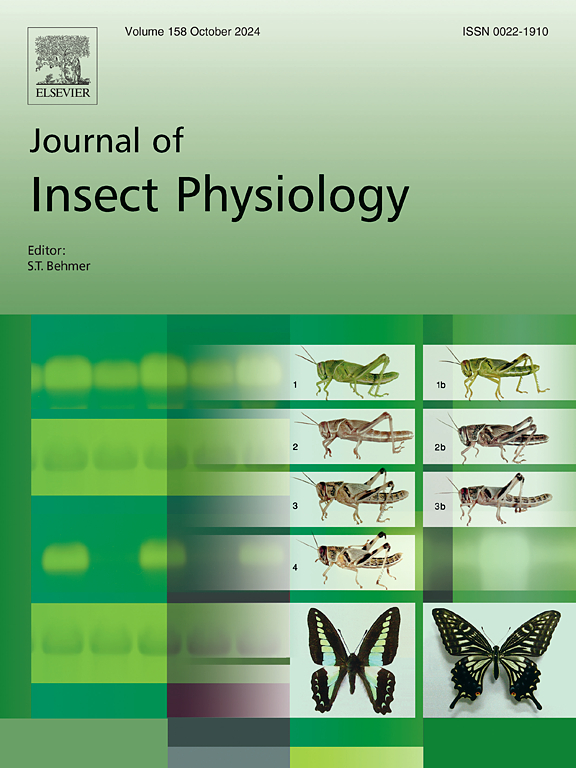Fox基因在小菜蛾发育和繁殖中的作用
IF 2.3
2区 农林科学
Q1 ENTOMOLOGY
引用次数: 0
摘要
叉头盒(Fox)转录因子家族对控制昆虫的生理功能、代谢和发育至关重要。然而,Fox基因在十字花科作物的主要农业害虫小菜蛾(小菜蛾)中的作用仍然未知。本研究的目的是对PxFox1基因进行鉴定,并探讨其在小菜蛾生殖发育中的作用。从小菜蛾基因组中鉴定出狐狸基因PxFox1。狐基因在鳞翅目中具有保守性,存在叉头结构域。PxFox1在小菜小菜的不同发育阶段和组织中均有表达,在雌性成虫和被中表达量较高。使用CRISPR/Cas9技术生成PxFox1敲除突变体。与野生型相比,突变体的卵数和孵化率显著降低。同时,突变体幼虫期延长,蛹期缩短,成虫寿命缩短。此外,PxFox1突变体表现出明显的表型异常,如翅膀畸形、身体分割不规则和体型缩小,突出了该基因在形态发育中的重要作用。这些结果表明,PxFox1在小菜蛾的发育、生存和繁殖中是必需的。以PxFox1为靶点,可为小菜蛾种群管理提供潜在的遗传控制策略,为害虫的可持续管理提供新的昆虫基因调控思路。本文章由计算机程序翻译,如有差异,请以英文原文为准。

Roles of Fox gene in the development and reproduction of diamondback moth
The forkhead box (Fox) family of transcription factors is essential for controlling physiological functions, metabolism and development in insects. However, the role of the Fox gene in the diamondback moth, Plutella xylostella, a major agricultural pest of cruciferous crops, is still unknown. The purpose of this work was to characterize the PxFox1 gene and investigate its role in the reproduction and development of P. xylostella. The Fox gene in P. xylostella (PxFox1) is identified from the P. xylostella genome. The Fox gene was conserved in lepidoptera with the presence of Forkhead domain. PxFox1 was expressed in different developmental stages and tissues of P. xylostella, highly in the female adult and integument. The PxFox1 knockout mutants were generated by using the CRISPR/Cas9 technique. The significant reduction in the number of eggs and hatching rate was observed in mutants as compared with the wild-type. Meanwhile, an extended larval duration, shortened pupal phase, and reduced adult lifespan were observed in the mutants. Furthermore, PxFox1 mutants displayed significant phenotypic abnormalities such as malformed wings, irregular body segmentation, and reduced body size, highlighting the gene’s essential role in the morphological development. These results showed that PxFox1 is necessary for P. xylostella development, survival, and reproduction. Targeting PxFox1 could provide a potential genetic pest control strategy for managing P. xylostella populations, offering new insights into insect gene regulation for sustainable pest management.
求助全文
通过发布文献求助,成功后即可免费获取论文全文。
去求助
来源期刊

Journal of insect physiology
生物-昆虫学
CiteScore
4.50
自引率
4.50%
发文量
77
审稿时长
57 days
期刊介绍:
All aspects of insect physiology are published in this journal which will also accept papers on the physiology of other arthropods, if the referees consider the work to be of general interest. The coverage includes endocrinology (in relation to moulting, reproduction and metabolism), pheromones, neurobiology (cellular, integrative and developmental), physiological pharmacology, nutrition (food selection, digestion and absorption), homeostasis, excretion, reproduction and behaviour. Papers covering functional genomics and molecular approaches to physiological problems will also be included. Communications on structure and applied entomology can be published if the subject matter has an explicit bearing on the physiology of arthropods. Review articles and novel method papers are also welcomed.
 求助内容:
求助内容: 应助结果提醒方式:
应助结果提醒方式:


